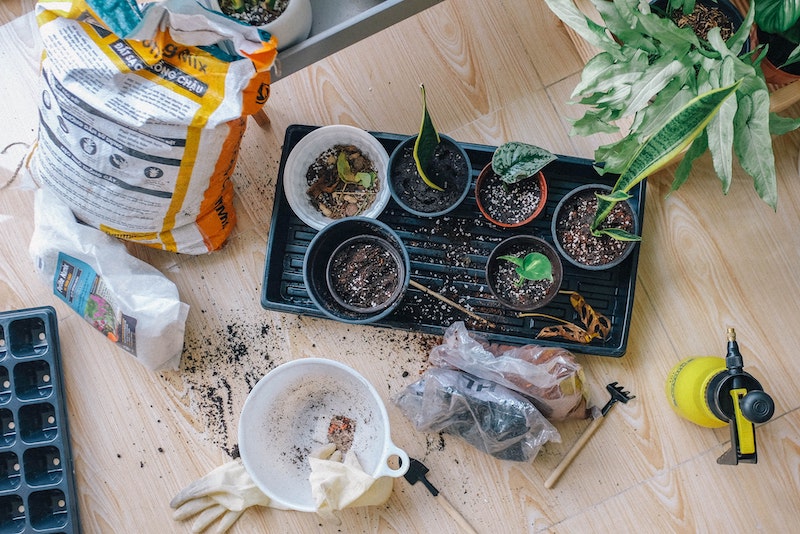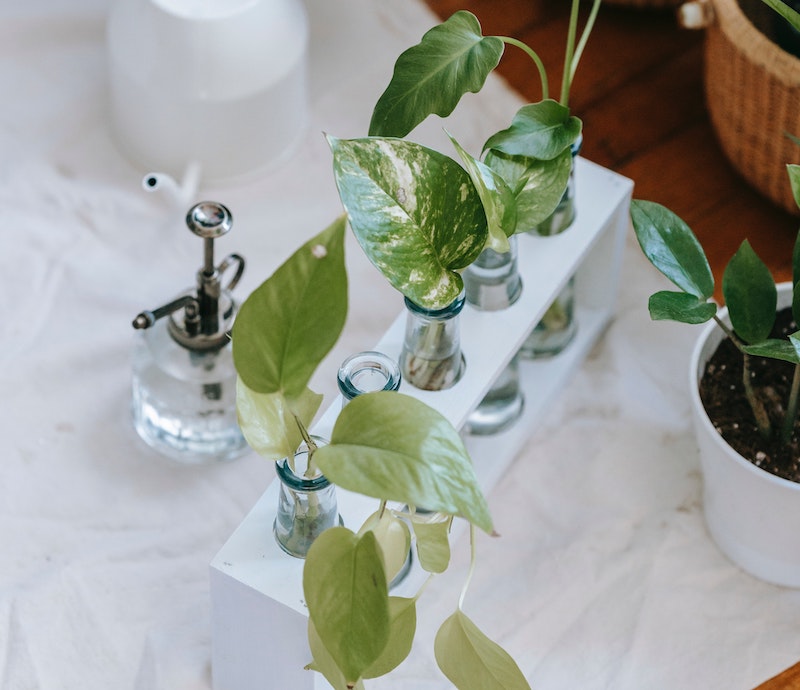Propagating houseplants is a fun and simple way to increase your houseplant population or provide new plants for friends and family. While there are dozens of methods of propagating houseplants, some may be more suitable than others depending on the plant. It is a good idea to do a bit of research about your individual plant prior to propagating, though each method is pretty low stakes and unlikely to harm the mother plant.

Methods To Propagate Houseplants
There are four main methods when it comes to propagating houseplants: by seed, stem/leaf/root cuttings, air layering, and division. Propagating by seed is more difficult in a home setting because many houseplants do not flower in our homes. The easiest and most common way to propagate houseplants is by taking cuttings. When you take cuttings from vining or trailing plants like pothos and philodendron, their nodes (area located just beneath a leaf that has the ability to grow roots) can be placed in a jar of clean water. When the cuttings produce roots, they can be planted into a small pot. For some plants like ZZs and sansevieria, you can take sections of their leaves and place them in water or soil. Some plants will only root by cuttings if provided with rooting hormone.
Air layering is a more involved propagation method that works well for those plants with sturdier, unbendable stems or trunks like Ficus and Schefflera trees. To air layer, a section of bark is removed from a secondary branch toward the top of the plant. There, rooting hormone is applied and the area wrapped in damp moss and plastic wrap, prompting the plant to grow roots at this point. This branch can then be removed and repotted.
Especially helpful when plants have outgrown their pots, division is an easy way to propagate houseplants. To divide a plant, remove it from the pot, locate a section of the plant, and carefully pull its roots away from the rest of the root ball. Depending on the plant, there may be a sturdy lateral shoot attaching the new plant to its parent, so some cutting may be necessary. Clump-forming houseplants that are easy to divide include sansevieria, peace lilies, and spider plants.

Best Rooting Media To Propagate Houseplants
The type of media used to propagate houseplants is going to greatly rely on what kind of plant you are working with. While some houseplants do best rooted in water first, others like succulents and cactus can be placed directly into a well-draining soil. Rooting houseplants may require consistently moist soil, so choosing something like a peat- or coco coir-based potting medium is best for water retention. All plant roots need access to air, so it is important to choose a potting media that will not become compact or hard.
Steps To Propagate Houseplants
Step 1 - Determine what kind of plant you are working with.
Step 2 - Choose the best method for propagation.
Step 3 - Use clean, sterile tools and potting equipment to prevent the spread of disease.
Step 4 - Start small – a smaller pot is easier to monitor for watering a rooting plant than a large pot with excess soil.
Step 5 - Rooting plants need more attention than fully grown ones, so stay on top of watering and be sure to provide plenty of bright, indirect light.
Step 6 - Size up – houseplants can typically stay in the same pot for a couple years at a time.
Caring For Houseplant Cuttings
If you are propagating houseplants via cuttings, it is important to cut the plants at the right spot. For a pothos or philodendron, for example, this can be as easy as locating the nodes. Beneath the leaf petioles, you may see some small nubs on the stem. These nubs are nodes and have the potential to grow roots. Place these nodes in water, provide the plant with plenty of bright, indirect light, and watch for roots. It is a good idea to change the water every week to prevent algae and bacterial growth that could impact your cutting’s success.
Not all houseplants can easily produce roots as cuttings. If you are not seeing roots after a few weeks, try dipping the cutting into rooting hormone or use a rooting solution. Some plants that may require this extra step include English ivy and dracaena.

Transplanting Houseplant Cuttings
Once your cutting has produced about a handful of roots, it is ready to be planted into a pot. Choose a pot that is about the size of the root ball. Keeping your new plant in a smaller pot will make the transition into soil a bit smoother as watering will be easier. Hold the new plant in its new pot with one hand while pouring soil in with the other. Gently tamp down the soil as you go. It is important to pack the soil around the roots just firm enough so that the plant is supported while also allowing water to flow through the pot easily. Once the new plant is potted, give it a thorough drink. This plant’s roots are used to being in water, so keep the soil moderately moist for the first week or so, gradually cutting back on watering until you can care for it the same way as the mother plant.
 |
Author Lynn Gusman - Published 1-18-2023 |
